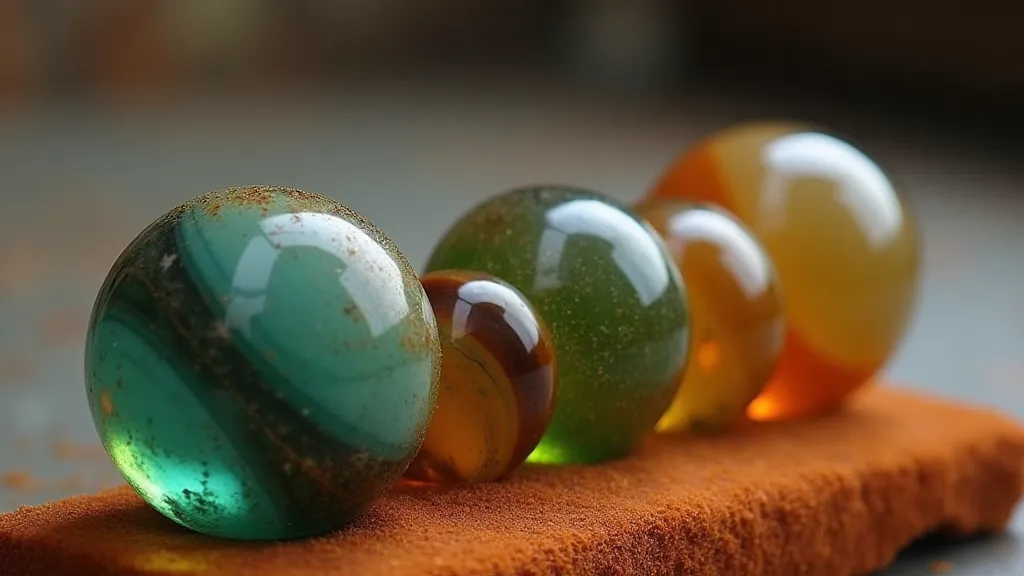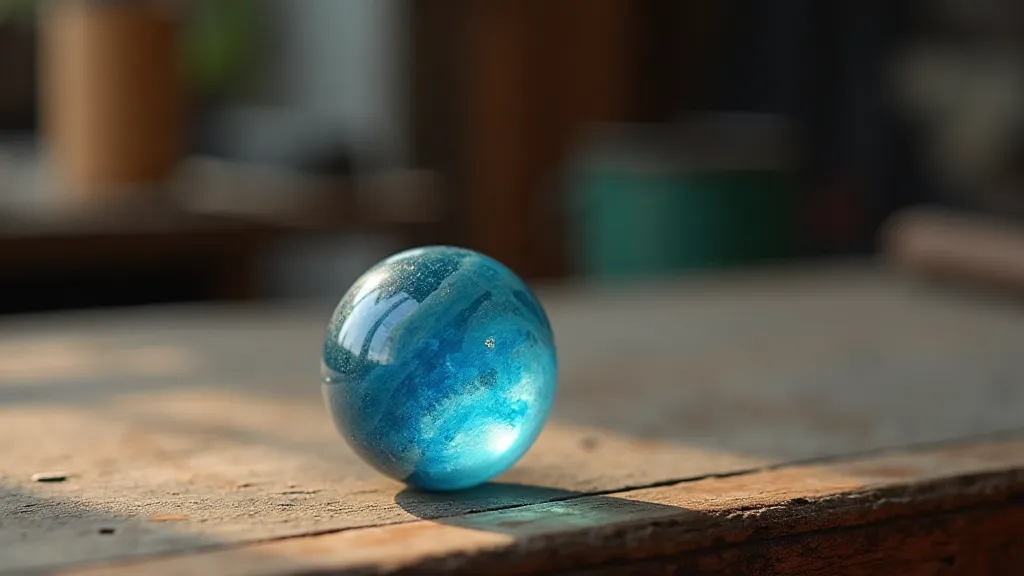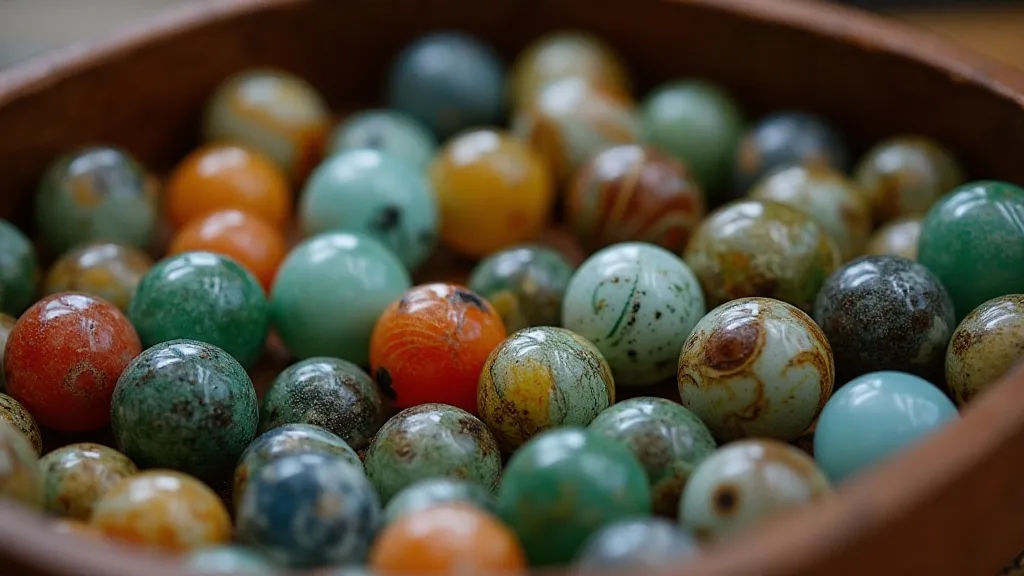Symphony of Silica: Unveiling the Mineralogy of Antique Glass Marbles
There's a particular feeling that settles over you when you hold an antique marble. It’s more than just the cool smoothness of the glass against your palm; it's a connection to a forgotten time, to the hands that crafted it, and the children who chased it across sun-drenched fields. These aren't just toys; they are tiny, perfectly formed vessels of history, each whispering tales of ingenuity and childhood delight. But behind that nostalgic warmth lies a surprisingly complex story – a story rooted in mineralogy, chemistry, and the tireless pursuit of beauty.
My own fascination began years ago, rummaging through my grandfather's attic. Amongst the dusty trunks and forgotten treasures, I found a small pouch filled with marbles. Not the pristine, factory-perfect ones of today, but clouded, slightly imperfect spheres, their colors muted and their surfaces worn. They felt different somehow, imbued with a quiet dignity. It was a gateway to a passion that has consumed me ever since – the pursuit of understanding these miniature masterpieces.

The Building Blocks: Minerals and Their Roles
The magic begins with the raw materials. Antique glass marbles weren't conjured from thin air. They were the product of careful selection and blending of minerals, primarily silica (sand), soda ash (sodium carbonate), and lime (calcium oxide). Silica, derived from quartz, formed the foundation of the glass, the very skeleton of the marble. Soda ash acted as a flux, lowering the melting point of the silica, making it easier to work with. Lime added stability and durability, preventing the glass from dissolving over time – a crucial element for longevity.
But the true artistry lay in the additions that would give each marble its unique color and visual character. Copper oxides brought vibrant greens and blues. Cobalt created intense azure hues. Manganese produced purples and browns. Iron could yield a spectrum of colors, from yellows to deep reds, depending on the conditions of the melting process. These metals weren’t simply tossed in; their interaction with the other minerals, the temperature of the furnace, and even the composition of the clay used for crucibles all influenced the final outcome. It’s a delicate dance of chemistry, and a slight variation could result in a drastically different shade.
The Furnace's Song: Craftsmanship and Technique
Imagine the 19th-century marble-making workshops - often family-run affairs – filled with the heat and roar of coal-fired furnaces. These weren't automated factories, but small-scale operations where skilled artisans, often children, meticulously shaped and manipulated molten glass. Early methods involved pouring the molten glass into molds or, more commonly, using hand-rolling techniques. The "pulleys," typically young boys, would quickly roll the hot glass between two flat surfaces, using water to keep the surface cool and maintaining a consistent shape. The speed, skill, and even the humidity of the air played a role in the final result.
One of the most sought-after varieties, "cat's eye" marbles, exemplifies this skill. These weren't achieved by accident. They were created by embedding a spiral of molten glass – often a contrasting color – within the main sphere. The result is a striking band that appears to move as the marble is rotated, creating a mesmerizing effect. The consistency and centering of this swirl demanded an exceptional level of control and experience. To replicate this effect today would require advanced machinery, yet it was routinely achieved by hand nearly two centuries ago.
Color Variations and Their Stories
The color of an antique marble isn't just aesthetically pleasing; it's a historical record. The availability of specific minerals varied geographically and over time, influencing the color palettes of different marble-producing regions. For example, sulfur, used to create yellows and oranges, was often a byproduct of mining operations. Periods of economic hardship or resource scarcity directly impacted the colors readily available to marble makers.
The "suzies," marbles with a distinct milky white base color with swirls of vibrant color, often demonstrate this beautifully. Their opacity stemmed from the addition of tin oxide to the glass mix. The specific shade and intensity of the swirls often hint at the specific tin source and the unique melting techniques employed by different workshops. Even the subtle imperfections – the tiny bubbles trapped within the glass, the slight color variations – contribute to the marble’s unique character and historical significance.

Beyond Beauty: Durability and Restoration Considerations
The durability of antique glass marbles is a testament to the quality of the raw materials and the skill of the craftsmen. While most exhibit signs of wear – surface scratches, clouding, and slight discoloration – they have endured for generations. The presence of lime in the glass mixture played a critical role in resisting chemical weathering, preventing the glass from dissolving in rainwater or soil.
However, modern cleaning methods can often be detrimental. Harsh chemicals can strip away the natural patina, which, while seemingly unattractive, often provides a protective layer. Gentle cleaning with warm water and a soft cloth is generally the safest approach. Restoration, in the truest sense, isn't about returning the marble to a pristine state; it’s about preserving its existing character and halting further degradation. Understanding the mineral composition is crucial here; aggressive polishing can inadvertently damage the glass, causing it to crumble.
The Enduring Legacy: A Mineral Symphony
The antique glass marble is more than just a toy; it is a miniature embodiment of human ingenuity, a tangible link to a bygone era. Each swirl, each color, each imperfection tells a story – a story rooted in the earth’s minerals, the skill of the craftsmen, and the enduring power of childhood imagination. When you hold one in your hand, you are not just holding a piece of glass; you are holding a symphony of silica, a testament to the beauty that can be achieved when artistry meets mineralogy. The passion for collecting these little wonders isn't just about acquiring objects; it’s about uncovering the secrets of a lost world, one shimmering sphere at a time.






